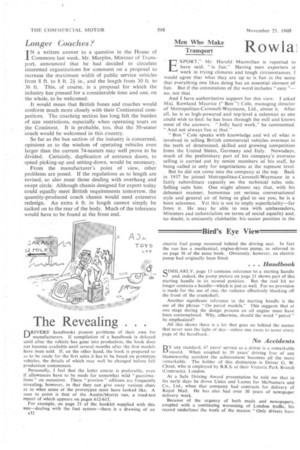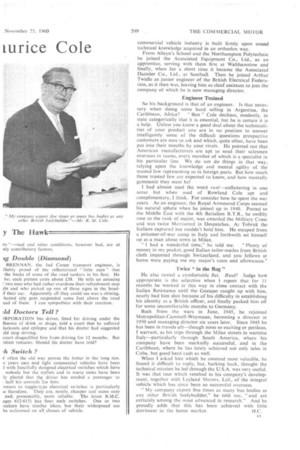Bird's Eye View
Page 34

Page 35

If you've noticed an error in this article please click here to report it so we can fix it.
y The Hawk electric fuel pump mounted behind the driving seat. In fact the van has a mechanical, engine-driven pump, as referred to on page 36 of the same book. Obviously, however, an electric pump had originally been fitted.
• • • Handbook SIM1LARLY, page 13 contains reference to ,a starting handle and, indeed, the pump picture on page 21 shows part of this starting handle in its stowed position. But the tool kit no longer contains a handle—which is just as well. For no provision is made for the use of one, the radiator effectively blocking off the front of the crankshaft.
Another significant reference to the starting handle is the use of the phrase "On petrol models." This suggests that at one stage during the design process an oil engine must have been contemplated. Why, otherwise, should the word " petrol " be emphasized? All this shows there is a lot that goes on behind the scenes that never sees the light of day—unless one cares to scour every page of the handbook.
No Accidents
BYany standard, 47 years' service as a driver is a remarkable record. When coupled to 39 years' driving free of any blameworthy accident the achievement becomes all the more remarkable. The holder of this distinction is Driver G. W. Choat, who is employed by B.R.S. at their Victoria Park Branch (Contracts), London.
At a Safe Driving Award presentation he told me that in his early days he drove Unics and Lacres for McNamara and Co., Ltd., when that company had contracts for delivery of Royal Mail. He has also had over 30 years of newspaper delivery work. Because of the urgency of both mails and newspapers, coupled with a continuing worsening of London traffic, his record underlines' the truth of the maxim "Only drivers have its "—road and other conditions, however bad, are at nly contributory factors,
Double (Diamond)
BRENNAN, the Ind Coope transport engineer, is ifiably proud of the reflectorized "little man" that the backs of some of the road tankers in his fleet. He be; each picture costs about £38. He tells an amusing two men who had rather overdone their refreshment stop ght and who picked up one of these signs in the headIf their car. Apparently all they could see was'a shining, 'hatted city gent suspended some feet above the road ead of them. I can sympathize with their reaction.
ld Doctors Tell ?
)RF'ORATION bus driver, fined for driving under the fluence of drink or drugs, told a court that he suffered lackouts and epilepsy and that his doctor had suggested ald stop driving.
court disqualified him from driving for 12 months. But :stion remains: Should his doctor have told?
It Switch ?
V often the old way proves the better in the long run. 1r years cars and light commercial vehicles have been .1 with fancifully designed electrical switches which have nobody but the stylists and in many cases have been ly placed that the driver has needed a passenger to half his controls for him.
return to toggle-type electrical switches is particularly Le therefore. They are, surely, cheaper and more easy and, presumably, more reliable. The latest I3.M.C. ages 612-615) has four such switches. One or two rakers have similar ideas, but their widespread use he welcomed on all classes of vehicle.




















































































































